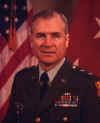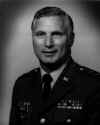1977
1977 Deployment of the M65 airborne TOW was completed to Europe during this year.
1977 The ARPA Support Office was redesignated the Defense Advanced Research Projects Agency (DARPA) Projects Office.
1977 The manager of the RSA Officers Club was one of four winners of the First Annual James A Carroll, Jr., Award for Excellence in Army Club Management. He was the only DARCOM winner in this Army worldwide competition.
January 77 The Plans and Analysis Directorate was established to manage the MIRADCOM integrated logistics support planning function and overall MIRADCOM weapon systems acquisition and resource planning process, in addition to other assigned responsibilities.
31 January 77 MICOM was abolished and its successors - MIRADCOM and MIRCOM - were activated at Redstone Arsenal. In compliance with Army Material Acquisition Review Committee (AMARC) recommendations, MIRCOM was oriented toward missile readiness, while MIRADCOM was dedicated to missile acquisition, research and development, and initial procurement.


31 January 77 BG Grayson D. Tate, Jr., the last MICOM DCG, became the first commander of MIRADCOM.

31 January 77 MG George E. Turnmeyer assumed command of MIRCOM.
31 January 77 The Foreign Intelligence Office became a separate staff element directly answerable to the MIRADCOM Commander. It had formerly been part of the Missile Intelligence Agency.
31 January 77 Effective with the activation of MIRCOM, the first civilian director of Procurement and Production assumed his new responsibilities. All previous directors had been military officers.
14 February 77 The Secretary of Defense authorized the Army to proceed with the development of the GSRS with an M42 dual purpose submunition warhead.
April 77 A new unit known as the a TOW light antitank battalion was established. The Oklahoma Army National Guard, selected as the test unit, received its TOW equipment during this month.
15 April 77 DARCOM established a provisional Advanced Heavy Antitank Missile System (AHAMS) Project Office to develop a replacement for the TOW missile.
17 April 77 The Post Safety Office, RASA, was merged with the Safety Office, MIRCOM Headquarters, to more efficiently use limited staffing, decrease paperwork, and simplify safety management activities.
May 77 The new Dental Clinic (Building 3493) was completed. The new structure replaced the one destroyed by the tornado that hit the installation on 3 April 74.

28 May 77 The 3d Battalion/81st Field Artillery, Korea, the last SERGEANT battalion in the U.S. Army, was phased out.
June 77 As directed by DA, the Organizational Effectiveness Office was established in PT&FD to assist commanders with improving organizational effectiveness by the systematic application of advance management and behavioral science skills and techniques.
June 77 The new LANCE nuclear warhead began receiving widespread publicity as the "neutron bomb." The Army designated enhanced radiation warhead was designed to release within a restricted radius great quantities of neutrons which attacked the human central nervous system. The warhead would reduce the heat and blast effects of conventional nuclear warheads, thus reducing facility destruction and collateral damage to civilian populated areas. It was believed that a Soviet attack would be deterred by the threat of weapons that could be used without destroying West Germany in order to save it.
July 77 The PLD Product Office was upgraded to a project office and renamed the Ground Laser Designators (GLD) Project Office, in keeping with an October 76 DARCOM decision to restructure the management of the GLD programs within the Army.
13 July 77 The U.S. Senate approved production funds for the enhanced radiation warhead (i.e., the "neutron bomb").
15 July 77 MG Charles F. Means assumed command of MIRADCOM.

18 July 77 The SERGEANT missile system was reclassified obsolete.
August 77 MIRCOM established a Small Business Committee to determine ways to enhance the command's Small Business Program.
15 August 77 One of the two remaining HONEST JOHN overseas battalions - the Korea-based 1st Battalion/42d Field Artillery - was deactivated. All three of the battalions remaining in the National Guard were also phased out. This left only one battalion in the U.S. Forces, the 1st Battalion/31st Field Artillery of the 2d Infantry Division (Korea).
29 August 77 Military Police personnel were removed from guard on all gates, except Gates 8, 9, and 10. These personnel were then used as an additional patrol covering the troop and housing areas of the arsenal.
31 August 77 The first charter for the GLD Project Office was approved.
September 77 The Kuwait Project Office was renamed the Kuwait/Jordan Missile Systems Project Office.
September 77 The new Post Exchange (Building 3220) was completed. Encompassing 50,814 square feet of floor space, the building was the first increment of the proposed Arsenal Community Center.
29 September 77 The TOW and DRAGON Project Offices were combined.
30 September 77 MG Louis Rachmeler assumed command of MIRCOM. This was his third tour of duty at Redstone Arsenal.

Read MG Rachmeler's biography
30 September 77 The Environmental Protection Agency (EPA) released the findings of a test of DDT levels in fish from the Triana, Alabama, area (located on the Tennessee River west of RSA). Both EPA and TVA issued public health announcements warning people to refrain from eating fish caught in the Tennessee River, Indian Creek, or Huntsville Spring Branch because fish in these waterways had excessive DDT levels.
October 77 Beginning late this month, after a meeting in Atlanta with representatives from EPA, the Food and Drug Administration (FDA), TVA, and the State of Alabama, the Army agreed to assume responsibility for developing temporary and permanent measures to contain DDT waste at the contaminated site on RSA. RASA crews worked to construct drainage ditches and two dams at the site. Completion of the project in early December 77 concluded the temporary phase of the cleanup operation.
1 October 77 The Office of the Project Manager for the GSRS was organized on a permanent basis.
17 October 77 The VIPER and AHAMS Project Offices were combined into the provisional VIPER-AHAMS Project Office.
November 77 DRAGON deployments were completed to USAREUR.
November 77 Officials of the Redstone Army Hospital and the School of Primary Care at the University of Alabama-Huntsville (UAH) signed an affiliation agreement permitting medical students and resident staff and faculty members of UAH to use the post hospital as part of their clinical teaching program.
Excellence in Missilery:
Introduction,
1962,
1963,
1964,
1965,
1966,
1967,
1968,
1969,
1970,
1971,
1972,
1973,
1974,
1975,
1976,
1977,
1978,
1979
